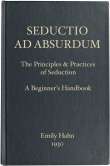قراءة كتاب Seductio Ad Absurdum The Principles & Practices of Seduction, A Beginner's Handbook
تنويه: تعرض هنا نبذة من اول ١٠ صفحات فقط من الكتاب الالكتروني، لقراءة الكتاب كاملا اضغط على الزر “اشتر الآن"

Seductio Ad Absurdum The Principles & Practices of Seduction, A Beginner's Handbook
Amateurs (those to whom the process of being seduced was a side line).[4]
However in late years there has grown up among us a third class, designated as (c), The only familiar term which has yet been applied was coined by Doctor Ethel Waters, who invented for them the descriptive appellation “freebies” in recognition of their independent stand in the matter of economics and convention. These revolutionists have formulated a philosophy which draws upon those of both older classes for its sources. To be freebie, seduction is neither a means of livelihood, as in the case of class (a), nor inevitable disgrace, as it is with class (b).[5]
It is undoubtedly this school of thought that influenced the Missouri jurist who, after a long and tiresome case of seduction, in which he found for the defendant, made a pronouncement from the bench to the effect that “There is no such thing as seduction.”[6] Although in my opinion this statement is somewhat extreme for our purposes, it serves to demonstrate the modern trend of sentiment.[7]
The modern social attitude had its prototype in the days of Cleopatra, where, as every classical scholar knows, the women of the upper classes exhibited an amazing independence. In Rome and Alexandria “the professional courtesans were gloomily complaining that their business had been hard hit by the fact that the ladies of fashion asked no payment for exertions of a similar nature.”[8]
Taking these facts into consideration, we must admit that in the light of modern improvement a new definition is required: one more in line with present day practice. For the purpose of this treatise let it be understood therefore that seduction is the process of persuading someone to do that which he or she has wanted to do all the time.
|
The Sexual Life of Savages. B. Malinowski. |
|
Domestic Manners of the Americans. By Frances Trollope. New York; Dodd, Mead and Company, 1927. |
|
Recreations of a Merchant, or the Christian Sketch Book. By William A. Brewer. Boston. See also Hatrack by Herbert Asbury, The American Mercury, April, 1926; and The Brass Check. By Upton Sinclair. Pasadena. |
|
The Beautiful Victim: Being a Full Account of the Seduction and Sorrows of Miss Mary Kirkpatrick (National Police Gazette: 1862). |
|
The Green Hat. By Michael Arlen. |
|
Eddinger versus Thompson: Harris j. |
|
For further exposition of juridical aspects of the subject see Die Zivilrechtlichen Ansprüche von Frauenspersonen aus aus-serehelichem Beischlafe: Hans Hochstein. |
|
Personalities of Antiquity ... Arthur Weigall. |
SEDUCTION IN HISTORY
The records preserved from older civilizations are (as has been said before) too fundamental in treatment to be of much value to us in the matter of details. We know, however, that the mythology and folklore of any race presents a more or less accurate idea of the customs of the time. Granting an amount of exaggeration in the fables, we have still the proof that seduction has always been a recognized practice in Heaven. Scarcely a god has not dabbled in the art at one time or another. In the first place they start off with the advantages of divinity and a working knowledge of black magic.[9] They could be called seducers in the true sense of the word only by courtesy. Jupiter, to take an example, used methods of archaic and brutal simplicity. To be sure, he would sometimes take the trouble to turn himself into a swan or a bull or a shower of gold, but such exercises are second nature to a deity and cause no delay or exhaustion. Ammon, the Egyptian god, associated exclusively with royalty, and no one thought of calling him to task for such moral irregularities. On the contrary, the kingly family was proud of him.[10]
A close study of the ancient Indians reveals the fact that they deemed seduction one of the most important of the arts, rivalling philosophy in popularity as a study.


